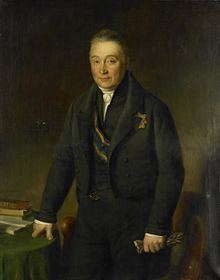Citizenship Dutch Children At least two sons | Nationality Dutch | |
 | ||
Full Name Adam Frans Jules Armand van der Duyn van Maasdam Spouse(s) Frederica Maria Isabella Benjamina van der Capellen (m. 1799, d. 1809) Parents Willem, Baron van der Duyn van 's-Gravenmoer en Maasdamlady Elizabeth Magdalena van Lijnden Died 19 September 1848, The Hague, Netherlands | ||
Adam Frans Jules Armand, Count van der Duyn, lord of Maasdam and 's-Gravenmoer (13 April 1771 - 19 September 1848) was Dutch officer and politician. He was part of the Triumvirate in 1813 that invited Prince William Frederick of Orange-Nassau to become Sovereign Prince of the Netherlands. He was born in Deventer, Overijssel.
Biography
He was a member of the Medieval noble family Van der Duyn (nl). He joined the army of the Dutch Republic as lieutenant, after completing his military education, in 1787. From 1789 till 1791 he studied Roman law at the University of Leiden. At the age of 20 he became Chamberlain of Prince William Frederick, the son of stadtholder William V. He belonged to the Orange party that opposed the more liberal Patriots who wanted to curtail the power of the stadtholder. However, Van de Duyn was quite enlightened and didn't belong to recationary wing of the Orange party. After the French occupation of the Dutch Republic and the establishment of the Batavian Republic, he retired from public service and devoted himself to study. He rented the Castle of IJsselstein and lived there with his wife Maria Baroness van der Capellen, who he had married in 1799. They were a very happy young couple, but Maria passed away after ten years of marriage. Van der Duyn was fond of literature and had his own private library. He preferred to read the works of Diderot, Rousseau, Bayle, Belle van Zuylen and Goethe. He was influenced by the liberal ideas of his age. He preferred a Constitutional Monarchy and was opposed to tyranny. He did sympathize with some of the ideals of the French revolutionaries, but despised the radicalism of the Jacobins. He seldom left his castle and choose to live a quiet life.
In 1811 Van der Duyn moved to The Hague. He joined the circle of conspirators around Gijsbert Karel van Hogendorp who were planning an uprising against the French occupators. In November 1813, when it came clear that Emperor Napoleon was losing the war against the Coalition, Van der Duyn, Van Hogendorp and Leopold van Limburg Stirum took power after an uprising which was planned carefully, and formed a Driemanschap (Triumvirate) that invited Prince William Frederick, the son of the last stadtholder, to come to the Netherlands and to accept the title of Sovereign Prince. On 30 November 1813 Prince William Frederick landed at Scheveningen. After the return of Prince William, a commission was set up to draft a Constitution. Van der Duyn was made a member of that commission that was headed by Van Hogendorp. In 1814 he was appointed a member of the Raad van State (Council of State). Besides that, he also became head of the Royal Household.
As a nobleman (predicate: Jonkheer, squire), he was entitled to join the Ridderschap, the College of Knights, of Zuid-Holland. When Prince William Frederick accepted the throne as King William I, Van der Duyn was given the title Count.
From 1817 till 1844 Van der Duyn served as governor of Zuid-Holland. King William made him Marshal of the Court in 1825. He continued to serve as Marshal of the Court under William II, who succeeded his father in 1840. In 1840s he supported the revision of the Constitution. In 1848 the King appointed Van der Duyn a member of the Senate in order to secure a majority for the constitutional revisions. He died shortly afterwards on 19 December 1848 in the Hague.
